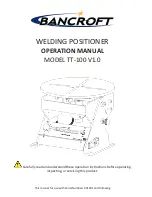
Installation of APEX 8000 Series Positioner on Actuators:
The APEX 8000 can be installed on most sizes of rotary and linear actuators. Actuators can be either double acting or
spring return. Cams can be used for direct acting or reverse acting directions. These instructions apply to rotary actuators
only. For linear actuator mounting instructions, consult the factory.
NOTE: For retrofitting to an actuator equipped with an Apex positioner, the same bracket and bolting may be used.
NOTE: NAMUR mounting is available with the APEX 8000 position-er. When retrofitting the APEX 8000 positioner to an
actuator equipped with another positioner, remove the existing posi-tioner, tubing and associated bolting. See tubing
instructions in Connecting APEX 8000 Positioner Ports section.
Mounting Instructions for APEX 8000 with NAMUR Shaft Connection
1. Mount the bracket to the actuator. Finger tighten the bracket bolting.
2. If required, install a coupler on the actuator shaft. Make sure the shaft and coupler are centered. See Figure 2.
3. Verify the orientation of the actuator and coupler flats match the positioner flats on the end of the shaft. Loosen the
cam if necessary. (See “Cam Installations” instructions.)
4. Install the positioner onto the bracket. Make sure positioner shaft and coupler are engaged and centered. Finger
tighten positioner bolts.
5. Proceed to “Connecting APEX 8000 Positioner Ports.”
Connecting APEX 8000 Positioner Ports:
1. For double acting actuators, connect positioner ports 1 and 2 to the actuator. Port 1 is always connected to the
actuator port used to drive the actuator away from its start or fail position (the factory cam setting is full clockwise at
minimum input signal).
NOTE: For single acting, spring return actuators, plug output port
2. Connect supply air to the port marked “SUPPLY.”
3. Connect air (for pressure inputs) or instrument tubing or wiring (for 4-20 mA inputs). For current inputs, the
terminal is marked (+) and (-) inside the I/P module. The I/P is factory calibrated and should not require adjust-
ment. If adjustments are necessary, see “Calibrating I/P Module Zero and Span Settings” section
.
Caution: Signal
air pressure higher than 30 psi may damage the module gauge and instrument signal capsule; a 3-15 psi instrument
signal is recommended on the pneumatic module.
4. Stroke actuator/valve two or three times to align positioner, coupler and actuator. With 50% input (actuator/valve
at 45 degrees), tighten all mounting bolts. Stroke actuator/valve again to verify there is no misalignment
throughout the stroke.
5. Calibrate valve and adjust cam if necessary. (See “Cam Installation” and “Positioner Calibration” instructions.)


















